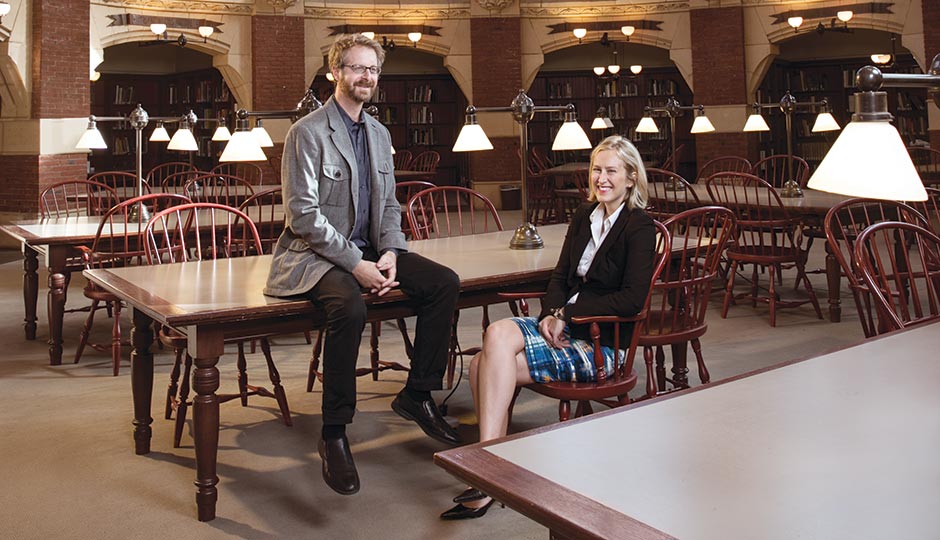Nathaniel Popkin and Diana Lind on Architecture

Nathaniel Popkin and Diana Lind at Penn’s Fisher Fine Arts Library. Photograph by Justin James Muir
NATHANIEL: The Athenaeum made both of our lists of favorite buildings in Philadelphia. What is it you like about it?
DIANA: The Athenaeum is like a bunch of other buildings in Philadelphia I adore: They’re set in time. They feel completely separate from what’s going on a couple blocks away on 8th and Market, which would be the total absence of feeling. When I compare the Athenaeum to a lot of architecture that we build today, I feel we’ve dumbed down the palette and created buildings intended to be timeless but that don’t transport you anywhere.
NATHANIEL: But contemporary architects have to deal with an extraordinary number of constraints. You have to satisfy the function of the building and contemporary aesthetic instinct — which is confusing because no one knows what that is. You also have to consider sustainability, budget, and maybe a site that’s difficult to work with. I think in many cases the architect is doing an admirable job trying to balance those things.
DIANA: Yes, but one of the things that’s lacking in a lot of residential buildings is a sense of daring. I don’t think the Piazza is a wonderful piece of architecture, but I do think 50 years from now, people will look at that section of Northern Liberties and think, What a weird moment. I compare that to what’s being built on South Broad Street, and there are developers with very bland buildings.
NATHANIEL: Yes, there’s no culture amongst Philadelphia developers that says, I need to beat that guy with my architecture. I’m going to outdo him.
DIANA: I feel like the places where you see interesting architecture these days are the universities. You can sense — especially with new presidents at Temple and Drexel — some competition there. Look at Penn’s new nanotechnology building.
NATHANIEL: The Singh Center for Nanotechnology at Penn is a great example of a daring building that arrests you as you walk by. How about another 21st-century favorite?
DIANA: The Barnes. Despite all the issues around moving it, I think at this point you’d be hard-pressed to say it was a bad idea. The way the architects simplified details of the building, the light — all of that feels beautiful.
NATHANIEL: I agree. I also like Drexel’s Millennium Hall, by Erdy McHenry. It looks like a woman with billowing skirts. It’s using contemporary technology and engineering to do something interesting.
DIANA: For the 20th century, I love the PSFS building in terms of the way it hits the street, its signage, the fact of it being America’s first
International Style skyscraper.
NATHANIEL: I once had the opportunity to ask architects what their favorite Philadelphia buildings were, and they all said the PSFS building. What about the 19th century?
DIANA: Reading Terminal. Part of me is like, darn, the Hard Rock Cafe — but there’s another part that’s so glad that mash-up is happening there. I love the way the building looks on Market Street. It feels like a perfect Philly moment: great architecture, crazy stuff happening on the street in front.
NATHANIEL: The 19th century is really difficult because that’s when Philadelphia was predominantly built. One of my favorites is the Frank Furness [Fisher Fine Arts] library at Penn. I love the curved wall, and the terra-cotta is particularly beautiful. When you sit in the reading room, you’re a student of a certain type and time.
DIANA: For the 18th century, I love Carpenters’ Hall. It’s a little gem, a little tiny cupcake of a building.
NATHANIEL: A cupcake! I love Christ Church. When it was built, it was the tallest building in North America, so there was that sense of ambition. It was that proof of religious freedom in America, because in the Quaker City, you could charter other religions. And also I love the facade. It’s crooked and really ancient-looking. It represents an almost baroque style that we don’t have much of in Philadelphia, yet it’s so much about Philadelphia and its role in the world at the same time.
*Hidden City and Next City are nonprofits focused on the built environment and urbanism. Originally published in the November 2014 issue of Philadelphia magazine.
Read more from our Conversation Issue.



